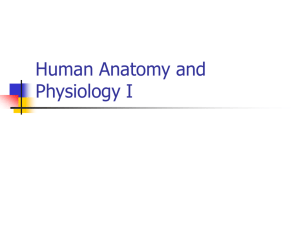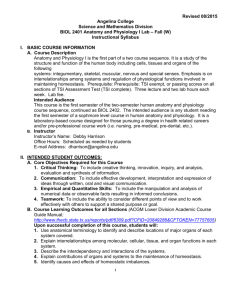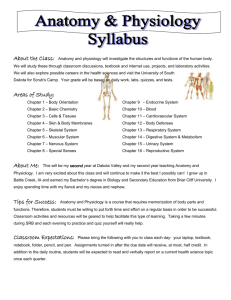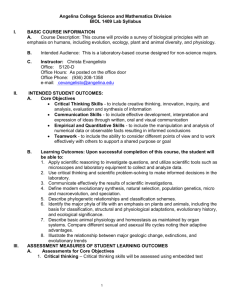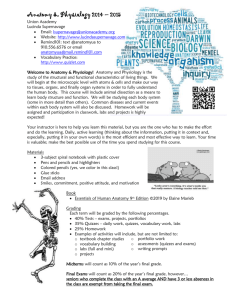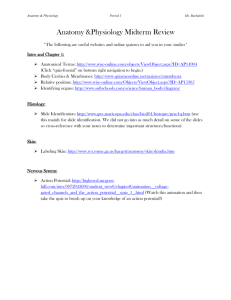Syllabus - Angelina College
advertisement
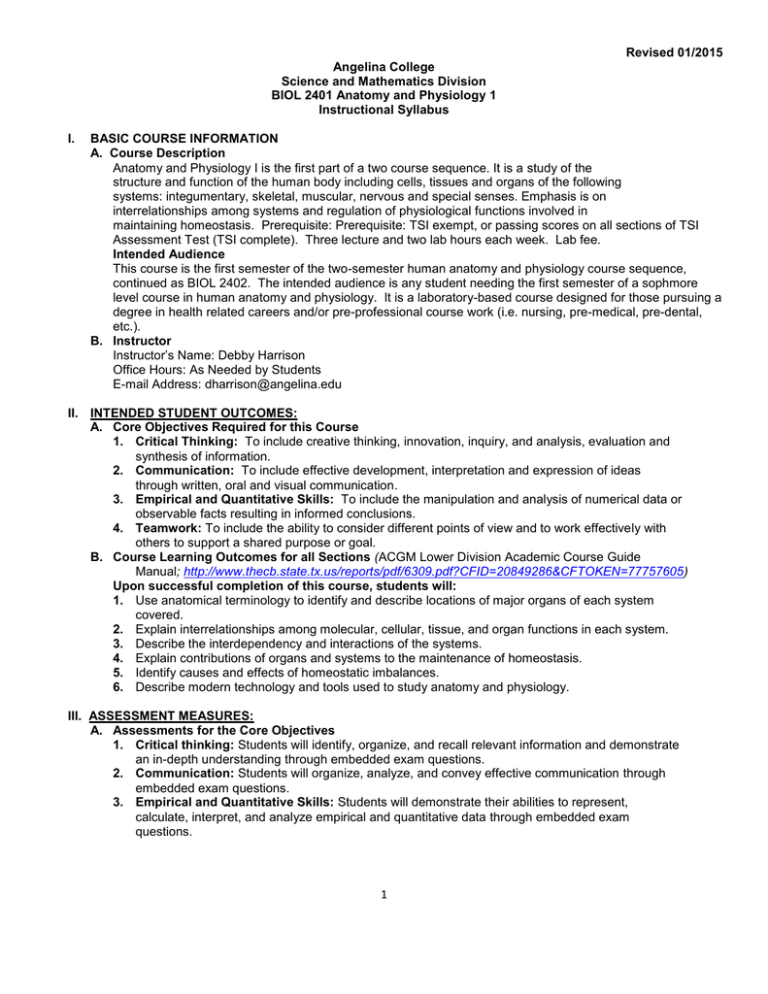
Revised 01/2015 Angelina College Science and Mathematics Division BIOL 2401 Anatomy and Physiology 1 Instructional Syllabus I. BASIC COURSE INFORMATION A. Course Description Anatomy and Physiology I is the first part of a two course sequence. It is a study of the structure and function of the human body including cells, tissues and organs of the following systems: integumentary, skeletal, muscular, nervous and special senses. Emphasis is on interrelationships among systems and regulation of physiological functions involved in maintaining homeostasis. Prerequisite: Prerequisite: TSI exempt, or passing scores on all sections of TSI Assessment Test (TSI complete). Three lecture and two lab hours each week. Lab fee. Intended Audience This course is the first semester of the two-semester human anatomy and physiology course sequence, continued as BIOL 2402. The intended audience is any student needing the first semester of a sophmore level course in human anatomy and physiology. It is a laboratory-based course designed for those pursuing a degree in health related careers and/or pre-professional course work (i.e. nursing, pre-medical, pre-dental, etc.). B. Instructor Instructor’s Name: Debby Harrison Office Hours: As Needed by Students E-mail Address: dharrison@angelina.edu II. INTENDED STUDENT OUTCOMES: A. Core Objectives Required for this Course 1. Critical Thinking: To include creative thinking, innovation, inquiry, and analysis, evaluation and synthesis of information. 2. Communication: To include effective development, interpretation and expression of ideas through written, oral and visual communication. 3. Empirical and Quantitative Skills: To include the manipulation and analysis of numerical data or observable facts resulting in informed conclusions. 4. Teamwork: To include the ability to consider different points of view and to work effectively with others to support a shared purpose or goal. B. Course Learning Outcomes for all Sections (ACGM Lower Division Academic Course Guide Manual; http://www.thecb.state.tx.us/reports/pdf/6309.pdf?CFID=20849286&CFTOKEN=77757605) Upon successful completion of this course, students will: 1. Use anatomical terminology to identify and describe locations of major organs of each system covered. 2. Explain interrelationships among molecular, cellular, tissue, and organ functions in each system. 3. Describe the interdependency and interactions of the systems. 4. Explain contributions of organs and systems to the maintenance of homeostasis. 5. Identify causes and effects of homeostatic imbalances. 6. Describe modern technology and tools used to study anatomy and physiology. III. ASSESSMENT MEASURES: A. Assessments for the Core Objectives 1. Critical thinking: Students will identify, organize, and recall relevant information and demonstrate an in-depth understanding through embedded exam questions. 2. Communication: Students will organize, analyze, and convey effective communication through embedded exam questions. 3. Empirical and Quantitative Skills: Students will demonstrate their abilities to represent, calculate, interpret, and analyze empirical and quantitative data through embedded exam questions. 1 4. Teamwork: Students will demonstrate their abilities to communicate effectively with team members, foster a constructive team climate, contribute to and support team activities, and respond to conflict by answering embedded exam questions. B. Assessments for Course Learning Outcomes 1. Students will use anatomical terminology to identify and describe locations of major organs of each system covered by answering written questions during lecture activities, on lecture exams, and by orally answering questions during presentations and class activities. 2. Students will explain interrelationships among molecular, cellular, tissue, and organ functions in each system by answering questions during lecture activities and on lecture exams. 3. Students will describe the interdependency and interactions of the systems by answering written questions during lecture activities and on lecture exams. 4. Students will explain contributions of organs and systems to the maintenance of homeostasis by answering written questions about case studies and on lecture exams. 5. Students will identify causes and effects of homeostatic imbalances by answering embedded exam questions and by answering written questions about case studies and current advances in medicine. 6. Students will describe modern technology and tools used to study anatomy and physiology by answering written questions about case studies or writing critical analyses of current medically related journal articles. IV. INSTRUCTIONAL PROCEDURES: This course will be taught using a combination of lectures and laboratory exercises that complement and supplement lecture material. Audio-visual materials, models, and dissection of specimens will be employed to enhance lecture and laboratory presentations. V. COURSE REQUIREMENTS AND POLICIES: A. Required Textbooks, Materials, and Equipment: 1. Human Anatomy and Physiology by Elaine Marieb (Benjamin/Cummings), Ninth Edition. 2. Human Anatomy and Physiology Laboratory Manual by Elaine Marieb (Benjamin/Cummings), Tenth Edition. 3. Student Study Guide to Accompany Human Anatomy and Physiology by Elaine Marieb (Benjamin Cummings) (OPTIONAL) 4. CD ROM - Packaged with textbook (OPTIONAL) 5. Access to blackboard (https://angelina.blackboard.com/webapps/login/). Obtaining a copy of the course Lecture Notes is highly recommended by the instructor for success in the classroom. Course lecture notes are available to print from the BIO 2401 blackboard site. 6. Students are required to supply their own scantron forms for test taking. Students will need 4 FORM NO. 884-E scantrons. B. Course Policies – (This course conforms to the policies of Angelina College as stated in the Angelina College Handbook.) 1. Academic Assistance: If you have a disability (as cited in Section 504 of the Rehabilitation Act of 1973 or Title II of the Americans with Disabilities Act of 1990) that may affect your participation in this class, you should see Karen Bowser, Room 208 of the Student Center. At a post-secondary institution, you must self-identify as a person with a disability; Ms. Bowser will assist you with the necessary information to do so. To report any complaints of discrimination related to disability, you should contact Dr. Patricia McKenzie, Administration Building, Room 105 or 936-633-5201. 2. Attendance: Attendance is required as per Angelina College Policy and will be recorded every day. Any student with three (3) consecutive absences or four (4) cumulative absences may be dropped from the class. Records will be turned in to the academic dean at the end of the semester. Do not assume that non-attendance in class will always result in an instructor drop. You must officially drop a class or risk receiving an F; this is official Angelina College Policy. 3. Additional Policies Established by the Individual Instructor: STUDENT CONDUCT A positive environment for learning will be maintained by students being courteous to each other and to the instructor. Arrive in class on time and do not prepare to leave before class is over, unless special arrangements have been made prior to class with the instructor. No eating in class. Cell phones should be on “vibrate only” (silent mode) or turned off. 2 Only one person speaks at a time. Distracting conversations during lecture will not be allowed. Respect all members of the class. Profanity will not be tolerated. Rude or provocative logos on clothing are not allowed in the classroom. Cheating on tests is not tolerated as per Angelina College policy and may result in expulsion from the course. Plagiarism is not tolerated and will result in a zero for any assignment in which it is detected. VI. COURSE CONTENT: Lecture content, schedule, and reading assignments Day Text Chapter Lab Chapter(s) Topic 1/26 Ch. 1 1-2 Introduction; The Human Body: An Orientation 2/2 Ch. 2 2/9 Ch. 3 2/16 2/23 4-5 Cells: The Living Units EXAM I (Text Chapter 1-3) Ch. 5 3/2 3/9 Chemistry Comes Alive 7 Integumentary System SPRING BREAK Ch. 6 3/16 8-11 Bones and Skeletal Tissues EXAM II (Text Chapter 5-6) 3/23 Ch. 9 3/30 Ch. 11 4/6 12-13 Muscles and Muscle Tissue Fundamentals of the Nervous System and Nervous Tissue EXAM IlI (Text Chapters 9, 11) 4/13 Ch. 12 17, 19 The Central Nervous System 4/20 Ch. 13 21 The Peripheral Nervous System and Reflex Activity 4/27 Ch. 14 20 The Autonomic Nervous System 5/4 EXAM IV (Text Chapters 12-13) 5/11 FINAL EXAM (Comprehensive) See the Final Exam Schedule posted on the Angelina College website for the exact time of all final exams. http://www.angelina.edu/final-exam-schedule/ 3 VII. EVALUATION AND GRADING: A. Grading Criteria (percents, extra credit, etc.) Questions for lecture exams and quizzes will be taken from lecture notes and textbook chapters. It is important for the student to understand that not all of the textbook information will be discussed in class, thus it is the students responsibility to read and study all chapter material (besides lecture notes) in preparation for an exam. Combined scores from lecture and laboratory constitute the final grade in the course: Lecture 4 Lecture Exams Lecture Quizzes Comprehensive Final = 100 points each = 100 points total (quizzes are averaged to reach this total)* = 100 points 600 ÷ 6 = 100 points Course average will be determined according to the following: Lecture Average (60%) Lab Average (40%) 100 x .60 = 60 100 x .40 = 40 100 B. Determination of Grade (assignment of letter grades) Grades for the course will be based on the following guidelines: A = 90 - 100 points B = 80 - 89 points C = 70 - 79 points D = 60 - 69 points F = 59 points C. Lecture Exams: There will be four lecture exams (worth a total of 100 points) that will be given as shown on the class schedule. These four exams include multiple-choice, short answer questions, and/or “essay”. The final exam is worth 100 points and will be 100% comprehensive (lecture and lab). The grade on the comprehensive portion of the final exam can replace the single lowest grade on the regular exams. Make-up exams are to the discretion of the instructor. D. Quizzes: A series of quizzes will be given during lecture. Some lecture quizzes (i.e. blackboard quizzes) are to be taken online and some will be given in class. Collectively, the lecture quizzes are worth a possible 100 points (i.e. the average of the quizzes will count as another exam grade). At least one lowest lecture quiz grade for the semester will be dropped. THERE WILL BE NO MAKE-UPS FOR MISSED QUIZZES WHETHER ONLINE OR IN CLASS. VIII. SYLLABUS MODIFICATION: The instructor may modify the provisions of the syllabus to meet individual class needs by informing the class in advance as to the changes being made. 4
